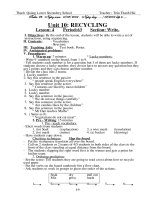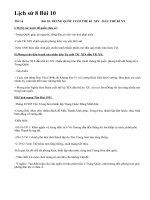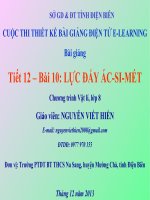TANH 8 BAI 10
Bạn đang xem bản rút gọn của tài liệu. Xem và tải ngay bản đầy đủ của tài liệu tại đây (157.59 KB, 21 trang )
Th¹ch Qu¶ng Lower Secondery School Teacher : TrÇn Thanh H¶i
TuÇn: 22. Ngµy so¹n: 11/02/ 2008 . Ngµy d¹y ..... / 02/2008 líp 8.....
Unit 10: Recycling
Lesson: 4 Period:63 Section: Write.
I. Objectives: By the end of the lesson, students will be able to write a set of
instructions, using sequencing.
II. Contents: - Vocabulary
- Structure:
III. Teaching Aids: Text book. Poster.
IV. Anticipated problems:
V. Proceduces:
1. Warm up: 7 minutes * Lucky numbers:
- Write 9 numbers on the board, from 1 to 9.
- Tell students each number is for a question but 3 of them are lucky numbers. If
students choose a lucky number, they do not have to answer any question but they
get 2 points and they can choose another number.
- Divide the class into 2 teams.
1. Lucky number
2. Say this sentence in the passive
“ people speak English everywhere”
3. Say this sentence in the active.
“ Cartoons are liked by most children”
4. Lucky number
5. Lucky number
6. Say this sentence in the passive.
“ We do not use things carefully”
7. Say this sentence in the active.
“ Are candies likes by the children”
8. Say this sentence in the passive
“ Mr Han teaches Maths”
9. ( Same as 8)
“ Vegetarians do not eat meat”
2. Pre - Writing: 15 minites
1. Pre - teach vocabulary.
- Elicit words from students
1. (to) Soak (explanation) 3. a wire mesh (translation)
2. (to) mash (mime) 4. (a) bucket (drawing)
- Have students copy down.
Checking technique: Slap the board.
- Put the vietnamese translatin all over the board.
- Call on 2 students or 2 teams of 4/5 students in both sides of the class to the front
of the class standing at equal distance from the board.
- -19
Th¹ch Qu¶ng Lower Secondery School Teacher : TrÇn Thanh H¶i
- The students slapping the right word first is the winner and gets a point for
his/her team.
2. Ordering prediction:
- Set the scene: Tell students they are going to read a text about how to recycle used
paper.
- Put the verbs on the board randomly bin a flow chart.
- Ask students to work in groups to guess the order of the actions.
Soak dry pull out
Mix press mash
1- 2- 3- 4- 5- 6-
- Call on about 2 pairs to write their answers on the board.
- Explain the process of recycling, using mimes or vietnamese and correct.
Answer key: 1. soak 2. mash 3. mix
4. pull out 5. press 6. dry.
3. While - Writing: 20 minites
- Ask students to open their books, read the text and fill in the verbs.
- Monitor and correct the exercise in the text book.-
Answer key: 1. use2. mix 3. place
4. press 5. wrap 6. wait 7. dry.
3. Recall:
- Ask students to close their books.
- Write the sequencing on the board and have students to practice speaking first.
- Call on students to say the sentences from memory.
First,………………..Then,…………………Next,……………………..
After,……………….Fanally,………………
- Get students to write the text in brief using the sequencing.
- Monitor and help students with their work.
- Call on some students to read their writing for the class.
- Give feedback and correct.
4. Ordering Pictures:
- Stick the photocopied pictures on the board randomly.
- Ask students to listen and work in groups to rearrange the pictures according to t
the instructions on how to prepare the tealeaves.
- Read the instructions aloud.
a. First take the used tealeaves from the tea pot.
b. Next scatter the tealeaves on the tray
c. Then dry the leaves in the sun.
d. Finally, put the dry leaves in apot for future use.
- Get students to give their answers.
- Correct.
5. Home work: 3 minites
- Write the instructions on how to make a thing you have ever made using the
sequencing.
TuÇn: 22. Ngµy so¹n: 11/02/ 2008 . Ngµy d¹y ..... / 02/2008 líp 8.....
- -20
Th¹ch Qu¶ng Lower Secondery School Teacher : TrÇn Thanh H¶i
Unit 10: Recycling
Period:64 Languege Foucus 2.3.4.
I. Objectives: By the end of the lesson, students will be able to form the passive in future simple and the
structures with adjectives..
II. Contents: - Vocabulary
- Structure:
III. Teaching Aids: Text book, cards.
IV. Anticipated problems:
V. Proceduces:
1. Warm up: 5 minutes * Question Game: What’s your job?
- Call on a students to go to the board and give him/her a job name.
- Ask the rest of the class to guess the job by asking yes – no questions.
- The chosen students can only answer yes or no.
Example questions:
Do you get a big salary?
Do you wear uniform?..........
- Tell students someone who can get the right job will get a point and take the place of the lat chosen
students.
2. Presentation: 10 minutes
1. Pre - teach Structures:
- Set the scene: Ask students to listen to the situation.
A famous inventor, Dr Kim, is going to build a time machine. One of his assistants, Hai, is asking him
questions about the invention. He wants to know when Dr Kim will start the project. How can he say the sentence in
the passive?
Model Sentences:
When will the project be started?
Will S be past partciple.
Concept checking:
USE: Passive Form in the Future Simple
Form: Will/ shall + be + past participle.
- Have students copy down.
3. Practice.
- Show students the questions and ask them to fill in the gaps, using the Passive.
1. It………… to the public when it is finished. (show)
2. …..It……..by the end of the year? (build)
3. It………before Tet. (finish).
4…………it ………by you? (made)
Answer key:
1. ……will be showed / shown…….
2. Will……..be built………..?
3. ………will be finished…………
4. Will…….be made……..?
3. Production: 15 minutes
2. Interview.
- Prepare 2 separate large cardboards, one for Dr Kim; one for Hai.
Hai Dr Kim
1. When /will /the project start/?
2. Many people / want / see /
time machine/
3. Will / it built / by the end /
year/?
4. Will/ it / make /by you?
5. Let’s begin tomorrow.
1. Very soon.
2. Yes. / it / show/ to the public
/when /it / finish/
3. I’m afraid not / but / it finish / before
Tet /
4. No, / I/ need you / build it/
When can you start?
- -21
Th¹ch Qu¶ng Lower Secondery School Teacher : TrÇn Thanh H¶i
- Tell students half of them are going to play the role of Hai to interview Mr kim, and the others
are Mr Kim.
- Model: Give one of the cardboards to a good student and ask him / her to demonstrate the
interview.
- Teacher (Dr Kim) – student (Hai)
- Stick the 2 cardboards on the board and get about 2 pairs to demonstrate.
- Deliver hand – outs to the whole class and ask them to do pair work.
- Monitor and correct.
3. Presentation:
1. Pre- teach Structures.
- Set the scene:
Ba gives Nam a lot of directions at a time so Nam find it difficult to follow Ba’s
directions. What does he say to Nam?
Model Sentences:
It is difficult to follow our directions.
It be adj to infinitive.
Concept checking:
Form: It + be + adjective + o infinitive
- Have students copy.
4. Practice:
2. Gap Fill.
- Ask students to open their books and complete the dialogues.
- Call all some pairs to dimonstrate the dialogues and correct.
5. Presentation:
1. Pre - teach structures:
- Set the scene:
Nam passed the English exam and his grandparents are delighted at it. What did they
write to him?
- Elicit the model.
Model Sentences:
We are delighted that you passed the English exam.
S be adj that / noun clause
Concept checking:
Form: S + be + adj + that/ noun clause
- Get students to copy
6. Practice: 10 minutes
2. Matching:
- Ask students to read the letter and match the words.
- Call on some students to go to the board to draw the lines.
1. Relieved (adj) a. xin chuc mung
2. Congratulations b. trong cho
3. Look forward to (v) c. xac nhan lai
4. Confirm (v) d. nhe nhom
- Ask students to copy the vocabulary.
7. Production: 3 minutes
3. Gap fill.
- Ask students to work in pairs to complete the letter using the words in the box.
- Get some students to give their answers.
- Give feedback and correct.
8. Homework: 2 minutes
- Rewrite the letter beginning with:
“ Nam’s grandparents are delighted that he……..
- Do the exercises in the workbook.
- -22
Th¹ch Qu¶ng Lower Secondery School Teacher : TrÇn Thanh H¶i
TuÇn: 22. Ngµy so¹n: 11/02/ 2008 . Ngµy d¹y ..... / 02/2008 líp 8.....
Unit 11: Traveling around vietnam
Period:65 Getting started – Listen and read
I. Objectives : By the end of the lesson, students will be able to use some expressions to
express their interest.
II. Contents: - Vocabulary
- Structure:
III. Teaching Aids: Text book, posters.
IV. Anticipated problems:
V. Proceduces:
1. Warm up: 5 minutes * Jumbled Words:
- Write the topic on the board: Places of interest
- Put the chart with jumbled words on the board.
Harbor Gate Halong
Nha rong Ngo mon
The templeBay
Literature
- Ask each team to connect the words to make the right phrases for places of interest and
write them on the board as fast as possible.
Answer Key:
Ngo Mon gate, Halong Bay, The Temple Literature, Nha rong Harbor.
* Getting Started:
- Ask students to open their books and match the names with the pictures.
- Call on some students to give their answers.
Answer Key:
a. Ngo Mon Gate b. Nha Rong Harbor
c. The Temple Literature d. Ha Long Bay
2. Pre – Reading : 10 minutes
1. Pre – teach Vocabulary .
- Elicit the words from students.
1, (a) crop ( translation/ explanation)
2, (a) sugar cane
3, (a) water buffalo ( translation)
4, (a) forty – minute drive ( explanation)
Example: The drive takes 40 minutes
- Ask students to notice that a plural noun must be changed to the singular form when
preceding the noun it modifies in a noun phrase.
- Have students drill some more:
1. The vacation lasted 3 months.
It was a 3 month vacation.
2.The boy is 13 years old.
He is a thirty - year - old boy.
- Have students copy down.
Checking technique: Bingo.
- Get students to brainstorm a list of 8 words and write them on the board.
- -23
Th¹ch Qu¶ng Lower Secondery School Teacher : TrÇn Thanh H¶i
Crop, sugar cane, water buffalo, rice paddy, a 40 minute drive, a 6 letter word, a five -
dollar note, a 200 - page book.
- Ask students to choose any 4 words/ phrases and copy them on their paper.
- Call out the words untill someone shouts “bingo”
2. Pre - questions : 10 minutes
- Set the scene.
- Put the chaert with the questions on the board.
1, Where does Hoa meet the Jones?
2, Is it the first time the Jones have visited Viet Nam?
3, How do they travel to Ha Noi?
4, What do they see along the road to Ha Noi?
5, What would Tim like to do?
- Check if students understand the questions and have them a few minutes to think about the
questions.
- Ask students to listen to the tape while reading the dialogue.
- Have students work in pairs to answer the questions.
- Call on some pairs to give their answers.
Answre key.
1, Hoa meets the Jones at the airport.
2, Yes, it is.
3, By Taxi.
4, They see a boy riding a water buffalo, rice paddies, corn and sugar cane fields.
5, He’d like to take a photo.
3. While - Reading: 10 minutes
3. True / False Statements.
- Ask students to listen and say out True or False.
- Read the sentences aloud and wait for students answers.
a. This is the first time Hoa has met Tim
’
s family.
b. Hoa helps Mrs Jones with her luggage.
c. The Jones family is traveling from the airport in a bus.
d. Shannon has never seen rice paddies before .
e. The car is travelling past farmland.
f. Only rice and corn are grown around Ha Noi.
- Ask some students to correct the false sentencesand have students write in their notebooks.
Answer Key:
a. True b. True c. False d. True e. True f. False.
4. Post - Reading: 8 minutes
4. Discussion:
- Ask students to read the dialogue again, discuss with them and ask them to pick out the
sentences containing the situations mentioned below.
* To express interest:
+ I’d like you to meet my parents…….
+ It’s nice to meet you….
+ It’s great to be in Viet Nam.
+ I’d like to sit with Tim…..
* To express a request:
+ Would you mind sitting in the front seat….
+ Would you mind if I took a photo?
5. Homework: 2 minutes
- Practise the dialogue in group of 5.
- -24
Th¹ch Qu¶ng Lower Secondery School Teacher : TrÇn Thanh H¶i
- Do the exercises in the Workbook.
TuÇn: 22. Ngµy so¹n: 11/02/ 2008 . Ngµy d¹y ..... / 02/2008 líp 8.....
Unit 11: Traveling around vietnam
Period:66 Speak – Language focus 3 - 4
I. Objectives: By the end of the lesson, students will be able to make and respond
to formal requests using “mind” and make suggestions.
II. Contents: - Vocabulary
- Structure:
III. Teaching Aids: Text book, pictures, poster.
IV. Anticipated problems:
V. Proceduces:
1. Warm up: * What does it say?
- Choose a students and ask him/ her back to the board so that he/ she cannot see
what is written on the board.
- Write the information on the board..
- Ask the rest of the class try to help the student guess what is written on the
board by asking questions until he / she says out right the words on the board.
Ex: On the board: Yes, I do.
Students ask: Do you like your teacher?......
On the board: Everyday.
Students ask: How often do you have a shower?
2. Presentation:
1.Pre - teach Structures.
- Set the scene.
Remind students of exchanges between Hoa and Mr. Jones and between Hoa
and Tim in the Last dialogue and elicit the sentences from students.
Model Sentences:
1. A: Would you mind sitting in the front seat of the taxi?
B: No problem.
2. A would you mind if I toke a photo?
B. Not at all.
* Concept checking:
Use: To make and respond to formal requests.
Form: 1. Would you mind / Do you mind + V-ing?
2. Would you mind if I + V(past)?
- -25
Th¹ch Qu¶ng Lower Secondery School Teacher : TrÇn Thanh H¶i
Do you mind if I + V(ifn)?
Responses: * Agreement: no I don’t mind/ no of course not/ not at all/ please do….
* Disagreement: i’m sorry, I can’t ; I’m sorry it’s impossible………..
Ex: Would you mind if I opened the door?
Do you mind if I close the windows?
Would/ Do you mind turning on the TV?
Agree: Not at all/ No problem/ Please do.
No, of cause not/ No, I don’t mind
Disagree: I’m sorry. I can’t
I’d prefer (rather) you didn’t.
I’m sorry. That’s not possible.
3. Practice:
2. Cardboard Drill:
- Prepare 4 cards with cues including checks(V) and crosses(X)
Ex: Would you mind moving your car?
- Go on with the same stepts for the second cue.
- Ask students to work through the rest of the cues.
4. Production:
- Demonstrate how to put the exchange together, using a good student.
Teacher: Would you mind moving your car?
Students : No, of course not.
- Open pairs:
- Closed pairs:
3. Mapped Dialogue:
- Set the scene:
You are a tourist on vacation in HCM city. You want to visit a market. This is the
conversation between you and tourist officer.
- Put the dilogue chart on the board.
- Open pairs:
- Closed pairs:
- Students in pairs should be assigned to work on different information each.
5. Homework:
- Choose information and write down 2 complete dialogues, using your own words.
- Do the exercises on the workbook.
- -26









